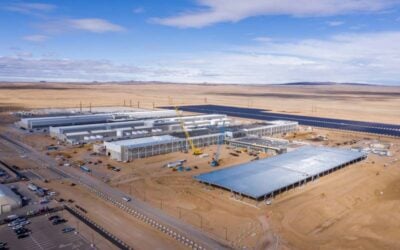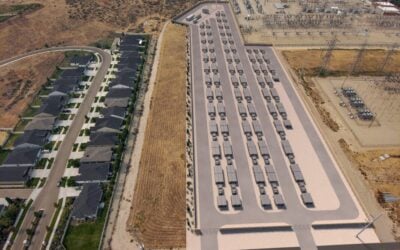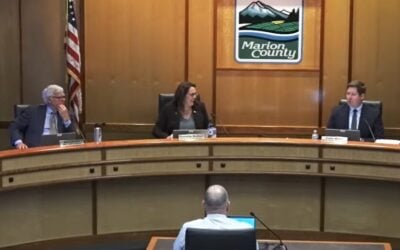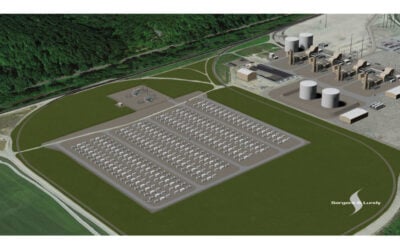
The US branch of Argentina’s PCR S.A. has cleared an important hurdle in the development of a hybrid solar and BESS project in southeastern Sandoval County, New Mexico.
On 18 February 2025, the Sandoval County Board of Commissioners approved a rezoning request for PCR’s Diamond Tail Solar and Storage project, despite vocal opposition.
Enjoy 12 months of exclusive analysis
- Regular insight and analysis of the industry’s biggest developments
- In-depth interviews with the industry’s leading figures
- Annual digital subscription to the PV Tech Power journal
- Discounts on Solar Media’s portfolio of events, in-person and virtual
Founded in 1929, PCR, known formerly as Petroquímica Comodoro Rivadavia S.A., has historically operated within the fossil fuel and cement industries across South America. More recently, the company has also branched out into renewables including owning and operating a 527MW six-project portfolio of wind farms in Argentina.
The US arm of PCR, known as PCR Energy, US, is headquartered in Houston, Texas, and first registered business subsidiaries in the Lone Star State during 2022, where it claims to be developing a 700MW portfolio of solar projects.
Although the company is keen to highlight its ‘green’ focus within its promotional material, it’s worth noting that PCR Energy U.S. holds an oil well drilling permit in Texas’ Wilson County under its PCR Energy LA, LLC subsidiary.
440MWh of Tesla Megapacks paired with 110MW solar PV in plan
As laid out in documentation provided to the public and to the board, PCR’s Diamond Tail project will pair a 110MW/440MWh BESS with a 220MW solar farm approximately 15 miles east of the neighbourhood of El Llanito on the border of Sandoval and Santa Fe counties, New Mexico.
According to project plans submitted to the council, the BESS will comprise 114 Tesla Megapack units, which PCR describes as ‘one of the safest battery storage products of its kind.’ While Tesla is mentioned in the project documentation, it remains unclear whether PCR has secured a supply agreement or plans to finalise one later.
PCR has secured site control for the project, which is expected to connect to the grid via Public Service Company of New Mexico’s (PNM’s) 345kV Diamond Tail substation (queue number IA-PNM-2022-02)
In terms of offtake, PCR hopes to secure a power purchase agreement (PPA) with PNM sometime between 2026 and 2028. Construction is expected to commence during the first half of 2027 and scheduled for completion during 2028.
Staunch opposition to project
Although Sandoval County’s Planning & Zoning (P&Z) Commission recommended approval of PCR’s rezoning request during December last year, a quasi-judicial hearing was held at the recent commissioners’ meeting due to the high numbers of people appealing the recommendation.
At the meeting, five individuals, who spoke on behalf of the opposition, were given 30 minutes to explain to the board why they believed PCR’s rezoning request should be denied.
As in many similar cases, opponents acknowledged the value of renewable energy but argued that this project was poorly sited. Opponents first raised concerns about visual pollution caused by the solar panels, followed by a speaker warning of potential BESS fire risks.
In particular, the individual gave a passionate account of the recent fire and overheating incidents at Moss Landing in Monterey County, California, using it as an example of what could happen in Sandoval County if a fire were to occur at PCR’s Diamond Tail project.
The hearing was the culmination of months of public hearings, discussion and back & forth between PCR and the local community of the New Mexico county.
New Mexico chosen due to ‘world-class natural resources’
Following the opposition’s presentation, Manuel Arancibia, the CCO of PCR Energy US, acknowledged the local community’s concerns with the project, particularly those regarding the safety of the development.
The CCO pointed to the industry’s high standards, stating that “only the best projects” secure financing and come to fruition. As to why the company picked the location, Arancibia said it chose New Mexico due to the state’s commitments towards renewable energy and “world-class natural resources”—referring to New Mexico’s state-wide high solar irradiance and emissions-free portfolio mandates for state investor-owned utilities (IOUs).
Arancibia also said the BESS was included in the project’s design to meet PNM’s procurement demands for more reliable and dispatchable sources of energy.
After two hours of testimony, rebuttal, and discussion amongst the board, the rezoning request was approved in a 3-2 vote.
Continued fallout from Moss Landing blaze
Despite the rezoning approval, recent BESS fires, and increased public scrutiny, will likely only make the permitting process increasingly challenging for developers.
The industry is still grappling with the aftermath of the Moss Landing incidents, which have led to temporary moratoriums and new legislative actions, as reported by Energy-Storage.news.
Added to this, a handful of residents in Moss Landing filed a lawsuit during the beginning of February claiming damages from who they believe are culpable for causing the fire. The suit calls for an investigation along with compensation for damages.
According to Monterey County’s website, North County Fire District and the Monterey County Sheriff’s Office responded to a ‘flare-up’ reignition at a burnt section of the Moss Landing site on 18 February 2025, which was contained by the early hours of the following morning.






